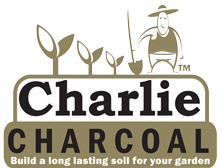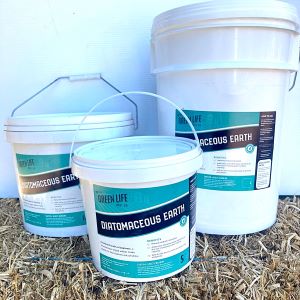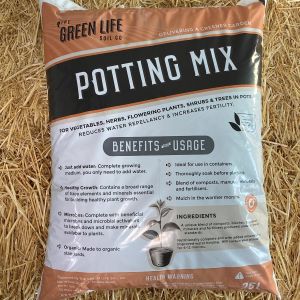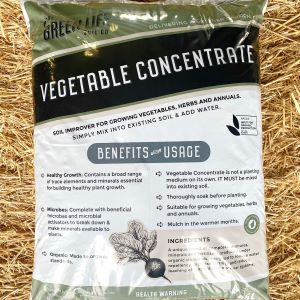| item(s), Total: $0.00 View Cart |
| Shopping cart is empty. |
Potatoes - How to Grow

Potatoes are a member of the Solanaceae family, and as such are related to tomatoes, capsicum and eggplants – something to take into account if you are following crop rotation principles.
Potatoes like a fertile, deeply dug, loose, moist slightly acidic soil (pH of approx. 6). They do not grow well in heavy clay. But don’t despair – if you have heavy clay the ‘straw’ or ‘tyre’ methods explained below can still give you a bumper crop of your own spuds.
Seed potatoes are recommended for planting; they tend to be smaller and specially selected, healthy stock. Commercial seed potatoes are sprayed to retard rotting. Look for Certified Organic seed potatoes which have not been treated - like the ones we sell @ GLSC. (However, they must be planted out quickly – they don’t have a long ‘shelf life’.)
Allow the eyes or buds to sprout (called ‘chitting’) by leaving them in a bright area for a few days. You can cut up potatoes into smaller pieces, but it is best to leave them for a further 24 hours to dry before planting; and be aware there is a risk of the cut potatoes rotting, particularly in humid areas or damp conditions.
Potatoes that are imported into WA for human consumption are, in fact, illegal to grow for biosecurity reasons. There are some plant diseases (not a problem for us humans - so consumption of the spuds isn't an issue) that our growers don't have in WA - so if you stick to growing seed potatoes you'll be protecting our industry.
There are several different methods of growing potatoes. Choose the method which suits your area, and personal preference. Try a couple of methods, and compare results!
Method 1 – Traditional
Prepare the site by digging to a depth of approx. 30cms, adding in well rotted compost, aged manure or our vegie concentrate soil. Mix in well. Purists should remove sticks and large stones as they may cause distortions in growing tubers. Water in well, and leave soil to settle for approx. 3 weeks.
When ready for planting, dig a trench approx. spade depth and check the moisture. Depending on season/location; the compost should have retained sufficient moisture for planting. (If dry, re-wet.) Plant the seed potatoes approx. 30cms apart with the largest eyes facing upwards. Backfill the trench. Do not allow the soil to completely dry out; but do not overwater either!! Assuming they have adequate drainage, the potatoes should not rot. Once the tops of the spuds are about 25cms high, mound up around each plant with more good quality soil. This will encourage a much heavier crop. Each seed potato should yield 10 potatoes at harvest.
Method 2 – No Dig (in garden bed)
Place the seed potatoes directly on the ground approx. 30cms apart. Cover with a 50/50 mix of straw blended with aged manure/compost/blood and bone. Allow a decent pile to cover the spuds - 30cm or so. The pile will settle. Water generously. In a couple of weeks, the tops will emerge through the straw. Keep topping up the ‘super straw’ mix. Ensure the tubers aren’t exposed to sunlight. This will turn them green and toxic.
Method 3 – Growing on straw (anywhere!)
The beauty of this method is you can actually grow on top of lawn, paving – anywhere!
Place a layer of straw 10 – 15cms thick on the ground, and put your seed potatoes on top, approx. 30cms apart. Cover with another thick layer of straw, plus aged manure, compost, and a good sprinkling of blood and bone. Water well.
As in Method 2 – keep adding to the straw as potatoes grow, and ALWAYS ensure the tubers are well covered. Mounds can be up to 50cms high to ensure good coverage, and allow maximum yield.
The beauty of these methods is that the straw can easily be lifted to check on growth, and potatoes can be harvested ‘ad-hoc’ when ready, without killing off the entire plant or disturbing other tubers.
Another advantage of Method 2 & 3 – you can cover the straw pile with a layer of clear plastic until shoots appear to help conserve moisture. Use common sense – allow air circulation and be careful in hot weather not to cook your plants.
Method 4 – Growing in Tyres
Now there are many arguments about this method! Tyres contain a number of toxic chemicals, and some people claim this can leach into your crop. Others argue this only happens when the tyres are exposed to light; so keep them covered with hessian or similar and you are OK. Still others claim that testing has been carried out and there has been no chemical leaching at all.
You will need to do your own research on this one and make your own choice!
It is a good option if you have very limited space, and you can get an excellent yield from a very small growing area.
Take one tyre, place it on the ground and put straw inside it. Place in about 6 seed potatoes on top, and cover with more straw. (Don’t skimp!) Put another tyre on top, continue layering straw, potatoes, straw, tyre until you have 4 -5 stacked up. Water lightly. Cover the top layer with at least 5cms of good soil. When shoots are approx. 30cms tall you can harvest the top layer by removing the straw & potatoes. Then take off the top tyre and in a couple of weeks you can harvest the next layer, and so on down to the bottom. Ensure the straw is damp but not over wet for optimum results.
If you don't like the concept of using tyres, any long, cylindrical bin/bucket can be used. Ideally, cut out the bottom to allow drainage. You can even buy fancy purpose made planters that have a lift up flap at the bottom so you can ferret around for developing spuds rather than disturb the entire planting.
When to harvest
Potatoes are ready to harvest once the plants begin to die back and yellow off (usually after flowering). This takes approx. 14 – 16 weeks depending on growing conditions. Early potatoes can be harvested ad hoc for table use at any time, but for best storage, potatoes should be fully mature. Tops will reach approx. 30 – 50cms height.
After they are dug, dry as quickly as possible and store immediately in a cool, dark, dry place. Exposure to light will turn the tubers green and poisonous.
If you forget any, there is a high likelihood they will re-grow next year and you’ll have even more to harvest!
When to plant
Potatoes can be grown many months of the year. They are frost tender, and need 60 – 90 days frost free to reach maturity for a successful harvest. If you are growing over winter in a frost affected area, provide a cover under plastic or light shade cloth attached to stakes or star pickets to allow air circulation. This can be removed if there is no frost imminent (to allow for rain to penetrate) – but remember to replace if another cold snap is forecast.
Most people choose to plant in Autumn, (March/April) as the soil is warm and growth is rapid. If where you live is frost free, they can be planted any time through to early spring and early summer – but they do not perform well in the hotter months and are more prone to pests and diseases. In frost prone areas plant early spring just prior to the last expected frosts (good luck with the predictions!).
Other Tips:-
- Try growing in an old sack, half wine barrel, or an aged compost heap.
- The smaller the space, the smaller the potatoes will grow.
- If you have prepared the soil well, additional fertilising is not generally required. However, a light feed of seaweed or comfrey tea to the tops can be given if you think the growth isn’t as lush as it should be.
- Plant potatoes in a sunny spot, but never allow the tubers to be exposed to light.
- Good Companion plants: beans, cabbages, corn, horseradish, nasturtium, peas, marigolds, parsnip.
- Bad Companion plants: cucumber, pumpkin, sunflower, onions, tomatoes, rosemary.
The Green Life Soil Co usually has a range of Certified Organic, WA sourced seed potatoes in Autumn/early Winter.
Visit our store, or online shop for a range of garden supplies and organic garden products.
Resources for Growing Organic Veggies & Herbs:
| item(s), Total: $0.00 View Cart |
| Shopping cart is empty. |


































